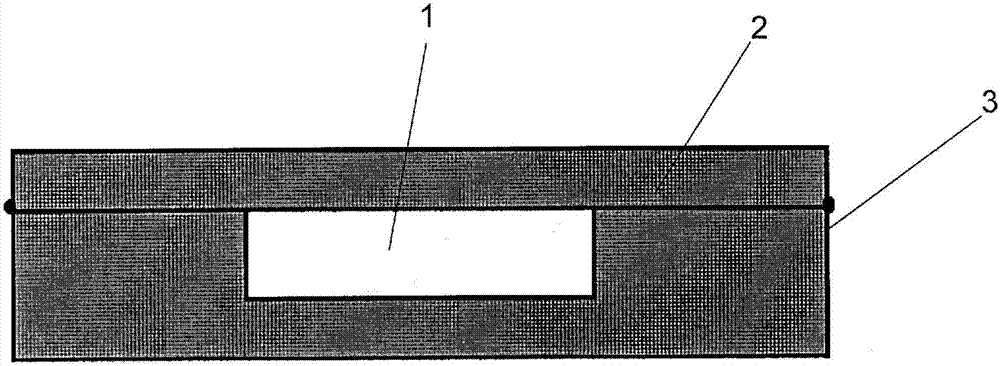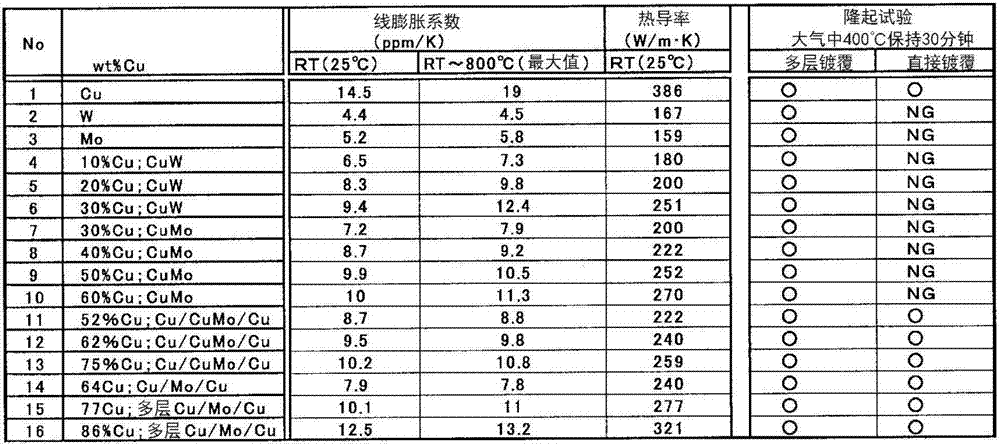Heat-dissipating substrate and method for manufacturing same
A heat-dissipating substrate and manufacturing method technology, applied in semiconductor/solid-state device manufacturing, transportation and packaging, liquid chemical plating, etc., can solve the problems of reduced thermal conductivity, reduced thermal conductivity, hindered cooling, etc., to achieve plating Dealing with Easy Effects
- Summary
- Abstract
- Description
- Claims
- Application Information
AI Technical Summary
Problems solved by technology
Method used
Image
Examples
Embodiment 1
[0122] (Example 1; CuMo with 40 wt% Cu, infiltration / densification / rolling, sample No. 6)
[0123] 3 wt% of 10 μm electrolytic Cu powder and 1 wt% of solid paraffin were mixed with Mo powder having an average particle size of 60 μm, and the obtained mixed powder was press-molded in a mold of 50 mm×50 mm, and the molded body was heated at 600° C. in hydrogen 60 minutes and dewax. Furthermore, it heated at 1000 degreeC in hydrogen gas, and produced the skeleton. A Cu plate was placed in the frame, and heated at 1250° C. for 60 minutes in a hydrogen atmosphere to infiltrate Cu. A 50 mm x 50 mm x 6 mm CuMo alloy composite was fabricated from 40 wt% Cu in this manner. Excess infiltrated Cu remaining on the surface layer of the alloy composite and defects in the surface layer were removed by cutting. This alloy composite was placed in a SUS box and degassed, and then the ends were welded and canned. It was cross-rolled at 800°C, taken out when the relative density of the alloy c...
Embodiment 2
[0128] (Example 2; CuMo with 40 wt% Cu, sintering / densification / rolling, sample No. 7)
[0129] Using Mo powder with an average particle size of 60 μm and electrolytic Cu powder with 10 μm, the powders were mixed at a compounding ratio of 40 wt % Cu and the balance Mo, and the obtained mixed powder was compression-molded with a mold of 50 mm×50 mm. The obtained compact was liquid-phase sintered at 1250° C. for 60 minutes in hydrogen to produce a CuMo alloy composite of 50 mm×50 mm×6 mm. Defects in the surface layer of the alloy composite were removed by cutting, the alloy composite was placed in a SUS case, degassed, and then the ends were welded for canning. It was cross-rolled at 800°C, taken out when the relative density of the alloy composite body reached above 99%, and solid-phase sintered at 950°C for 60 minutes in hydrogen. This alloy composite was subjected to 10 μm Cu plating treatment, and then cross-rolled at 400° C. to obtain a plate with a thickness of 2 mm. Tha...
Embodiment 3
[0133] (Example 3; CuW with 45wt% Cu, sintering / rolling, sample No. 20)
[0134] W powder with an average particle size of 60 μm and electrolytic Cu powder with 10 μm were mixed at a compounding ratio of 45 wt % Cu and the balance W, and the obtained mixed powder was compression-molded with a mold of 50 mm×50 mm. The compact was liquid-phase sintered at 1250° C. for 60 minutes in hydrogen to obtain a CuW alloy composite body of 50 mm×50 mm×6 mm.
[0135]Defects in the surface layer of the alloy composite were removed by cutting, the alloy composite was placed in a SUS case, degassed, and then the ends were welded for canning. It is cross-rolled at 800° C., taken out when the relative density of the alloy composite body reaches above 99%, and solid-phase sintered at 1000° C. for 60 minutes in hydrogen. This alloy composite was subjected to a 10 μm Cu plating treatment, and then cross rolled at 600° C. to a thickness of 2 mm. That is, the rolling reduction (=(6mm-2mm) / 6mm) of ...
PUM
| Property | Measurement | Unit |
|---|---|---|
| thickness | aaaaa | aaaaa |
| melting point | aaaaa | aaaaa |
| melting point | aaaaa | aaaaa |
Abstract
Description
Claims
Application Information
 Login to View More
Login to View More - R&D
- Intellectual Property
- Life Sciences
- Materials
- Tech Scout
- Unparalleled Data Quality
- Higher Quality Content
- 60% Fewer Hallucinations
Browse by: Latest US Patents, China's latest patents, Technical Efficacy Thesaurus, Application Domain, Technology Topic, Popular Technical Reports.
© 2025 PatSnap. All rights reserved.Legal|Privacy policy|Modern Slavery Act Transparency Statement|Sitemap|About US| Contact US: help@patsnap.com



